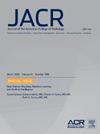Incidental Detection of Previously Unknown Strokes on Head CT Examinations: An Untapped Opportunity for Secondary Prevention
IF 5.1
3区 医学
Q1 RADIOLOGY, NUCLEAR MEDICINE & MEDICAL IMAGING
引用次数: 0
Abstract
Background
The incidental discovery of previously unknown strokes on neuroimaging is an opportunity to implement secondary prevention, reducing the risk of recurrent strokes by up to 80%.
Objective
To evaluate the prevalence of previously unknown strokes on emergency department (ED) head CT imaging and identify associated patient and imaging factors.
Methods
Retrospective study of adult patients receiving head CT (age ≥ 18 years) at three EDs between July and December 2023. Old strokes on CT imaging were categorized as previously known or unknown. Patient and imaging factors associated with unknown strokes were assessed via univariable regression, multivariable regression, and decision tree analysis.
Results
In 21,985 ED encounters with head CT, 869 (4.0%) examinations demonstrated an old stroke (mean age, 74.4 years ± 14.0 [SD]), of which 372 (43%; 1.7% of all CTs) were unknown. Univariable analysis showed that unknown strokes were associated with greater age (odds ratio [OR], 1.03; 95% confidence interval [CI]: 1.02-1.04; P < .001), a single site of old stroke (OR, 2.7; 95% CI: 2.06-3.58; P and < .001), smaller strokes (OR, 1.8, 95% CI: 1.6-2.0, P < .001), as well as gangliocapsular (OR, 2.8; 95% CI: 1.9-4.0; P < .001) and cerebellar location (OR, 2.1; 95% CI: 1.4-3.2; P < .001). Results of further analyses corroborated those of the univariable regression.
Conclusion
More than a third of old strokes on head CT imaging are unknown to patients and clinicians. Capturing this opportunity for secondary prevention could benefit 100,000 to 200,000 patients per year in the United States, based on trends in ED care.
在头部 CT 检查中偶然发现之前未知的脑卒中:二次预防中一个尚未开发的机会
背景:在神经影像学检查中偶然发现之前未知的脑卒中是实施二级预防的机会,可将复发脑卒中的风险降低 80%:在神经影像学检查中偶然发现之前未知的脑卒中是实施二级预防的一个机会,可将复发脑卒中的风险降低多达 80%:评估急诊科(ED)头部 CT 成像中先前未知脑卒中的发生率,并确定相关的患者和成像因素:方法:对2023年7月至12月期间在3家急诊科接受头部CT检查的成年患者(年龄≥18岁)进行回顾性研究。CT成像上的陈旧性脑卒中分为先前已知和未知两种。通过单变量回归、多变量回归和决策树分析评估了与未知脑卒中相关的患者和影像学因素:在 21985 次急诊室头部 CT 检查中,869 例(4.0%)显示为陈旧性脑卒中(平均年龄 74.4 岁 ± 14.0 [SD]),其中 372 例(43%;占所有 CT 的 1.7%)为未知脑卒中。单变量分析显示,未知脑卒中与年龄较大(OR,1.03;95% CI:1.02-1.04;P < 0.001)、单一部位的陈旧性脑卒中(OR,2.7;95% CI:2.06-3.58;P < 0.001)、较小的脑卒中(OR,1.8;95% CI:1.6-2.0,P 结论)相关:在头部 CT 成像中,超过三分之一的陈旧性脑卒中不为患者和临床医生所知。根据急诊室护理的趋势,抓住这一机会进行二级预防可使美国每年 10 万到 20 万名患者受益。
本文章由计算机程序翻译,如有差异,请以英文原文为准。
求助全文
约1分钟内获得全文
求助全文
来源期刊

Journal of the American College of Radiology
RADIOLOGY, NUCLEAR MEDICINE & MEDICAL IMAGING-
CiteScore
6.30
自引率
8.90%
发文量
312
审稿时长
34 days
期刊介绍:
The official journal of the American College of Radiology, JACR informs its readers of timely, pertinent, and important topics affecting the practice of diagnostic radiologists, interventional radiologists, medical physicists, and radiation oncologists. In so doing, JACR improves their practices and helps optimize their role in the health care system. By providing a forum for informative, well-written articles on health policy, clinical practice, practice management, data science, and education, JACR engages readers in a dialogue that ultimately benefits patient care.
 求助内容:
求助内容: 应助结果提醒方式:
应助结果提醒方式:


